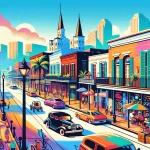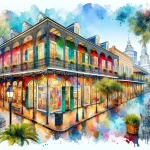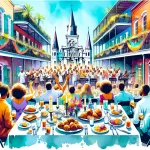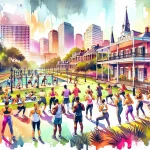New Orleans’ Julia Street, located in the Arts District, stands as an artistic haven, a captivating embodiment of the city’s creative spirit. This iconic street has undergone a remarkable transformation, evolving from an industrial hub to a thriving epicenter of art, culture, and community.
In This Article
TL;DR
- Julia Street showcases New Orleans’ vibrant artistic scene through numerous galleries, museums, and cultural spaces.
- Notable attractions include the Contemporary Arts Center, the Ogden Museum of Southern Art, and a variety of galleries featuring local and nationally acclaimed artists.
- Visitors can explore during monthly art walks, attend festivals like White Linen Night, and take advantage of convenient transportation options.
Historical Context of Julia Street
Tracing its roots back to the 19th century, Julia Street initially served as an industrial area, housing warehouses and storage facilities for goods shipped through the Port of New Orleans. As commerce practices evolved, the area’s prosperity waned, leaving once-bustling streets quieter.
However, the 1984 New Orleans World’s Fair proved a catalyst for revitalization. Old factories transformed into luxury condos, and street-level structures reimagined as art galleries, showcasing works by local and renowned artists. This transformation breathed new life into the area, solidifying Julia Street’s role as a cultural hub.
Compared to other historical streets like Royal and Magazine, Julia Street’s journey from industrial roots to artistic renaissance showcases the city’s resilience and ability to embrace change.
Major Attractions on Julia Street
Contemporary Arts Center
The Contemporary Arts Center offers a diverse range of exhibitions, performances, and educational programs, showcasing cutting-edge contemporary art from around the world.
Ogden Museum of Southern Art
The Ogden Museum of Southern Art, housed in a stunning five-story building, celebrates the rich artistic heritage of the American South, featuring works by renowned artists like Walter Anderson, Clementine Hunter, and John McCrady.
Galleries and Shops
Beyond these iconic institutions, Julia Street is lined with numerous galleries, each offering a unique glimpse into the vibrant local art scene. From the eclectic mix of mediums at the Jonathan Ferrara Gallery to the captivating sculptures at the Callan Contemporary, visitors can immerse themselves in diverse artistic expressions.
Unique shops and boutiques, like Perique Rare Craft Gallery and Vintage 329 Antique Mall, offer chances to take home a piece of New Orleans’ artistic legacy. Dining options range from casual eateries to upscale restaurants like Emeril’s, where visitors can savor flavors while surrounded by artistic ambiance.
Cultural Significance
Julia Street’s cultural significance extends beyond its physical boundaries, serving as a vibrant hub for local artists and fostering creativity. The street’s galleries and museums have played pivotal roles in shaping New Orleans’ cultural landscape, showcasing works of emerging and established artists.
Events and festivals like White Linen Night, Jammin’ on Julia, and Art for Arts’ Sake celebrate the street’s artistic spirit, attracting visitors and fostering a sense of community pride in the city’s cultural heritage.
The influence of local artists and cultural movements can be seen throughout Julia Street, with murals, installations, and public art pieces adorning the streetscape. These artistic expressions serve as a testament to the city’s rich cultural fabric and its commitment to preserving and celebrating its artistic roots.
Architectural Highlights
Julia Street’s architectural landscape harmoniously blends historic preservation and modern innovation. Buildings like the Contemporary Arts Center and Ogden Museum showcase a range of architectural styles, from sleek contemporary lines to ornate historic details.
Efforts to preserve the area’s architectural heritage have maintained Julia Street’s unique character. Buildings once housing warehouses and factories have been meticulously restored, retaining their historic charm while adapting to new roles as art spaces and cultural hubs.
Compared to other areas, Julia Street’s architectural diversity reflects New Orleans’ ability to embrace its past and future. The juxtaposition of historic and modern structures creates a visually striking and dynamic streetscape, inviting visitors to explore and appreciate the area’s rich architectural fabric.
Practical Tips for Visitors
To fully experience Julia Street’s magic, visitors should consider the following practical tips:
Transportation and Parking
While easily accessible on foot from the French Quarter, visitors can also take the St. Charles streetcar running directly to the area. Parking is available in nearby lots or surrounding streets, but arriving early or using ride-sharing services during peak hours is advisable.
Best Times to Visit
The monthly “First Saturday Gallery Openings” offer opportunities to explore new exhibits and mingle with local artists. Additionally, festivals like White Linen Night (first Saturday in August) and Art for Arts’ Sake (first Saturday in October) provide lively and immersive cultural experiences.
Engaging with Local Culture
To truly appreciate Julia Street’s spirit, visitors are encouraged to engage with local artists, attend gallery talks, and participate in workshops or classes offered by various cultural institutions. This hands-on approach fosters a deeper understanding and appreciation of the area’s artistic heritage.
Safety and Accessibility
New Orleans takes pride in ensuring a safe and accessible environment. Julia Street and the surrounding Arts District are well-lit and patrolled, providing a secure atmosphere for exploration.
Many galleries and cultural spaces have implemented accessibility features like ramps, elevators, and audio guides, ensuring visitors with disabilities can fully enjoy the artistic offerings. Organizations like the New Orleans Museum of Art and Arts District Association provide resources and information to assist visitors with specific accessibility needs.
Future Prospects and Developments
Julia Street’s future looks bright, with exciting projects and developments on the horizon. Upcoming initiatives, like the expansion of the Contemporary Arts Center and the revitalization of historic buildings, promise to further enhance the area’s artistic and cultural offerings.
These developments have the potential to attract more visitors and contribute to local community growth. However, as with any change, concerns exist about the potential impact on the area’s unique character and affordability for local artists and residents.
Compared to past changes like the revitalization efforts following the 1984 World’s Fair, these new developments aim to strike a balance between progress and preservation, ensuring Julia Street’s artistic spirit remains intact while embracing opportunities for growth and innovation.






